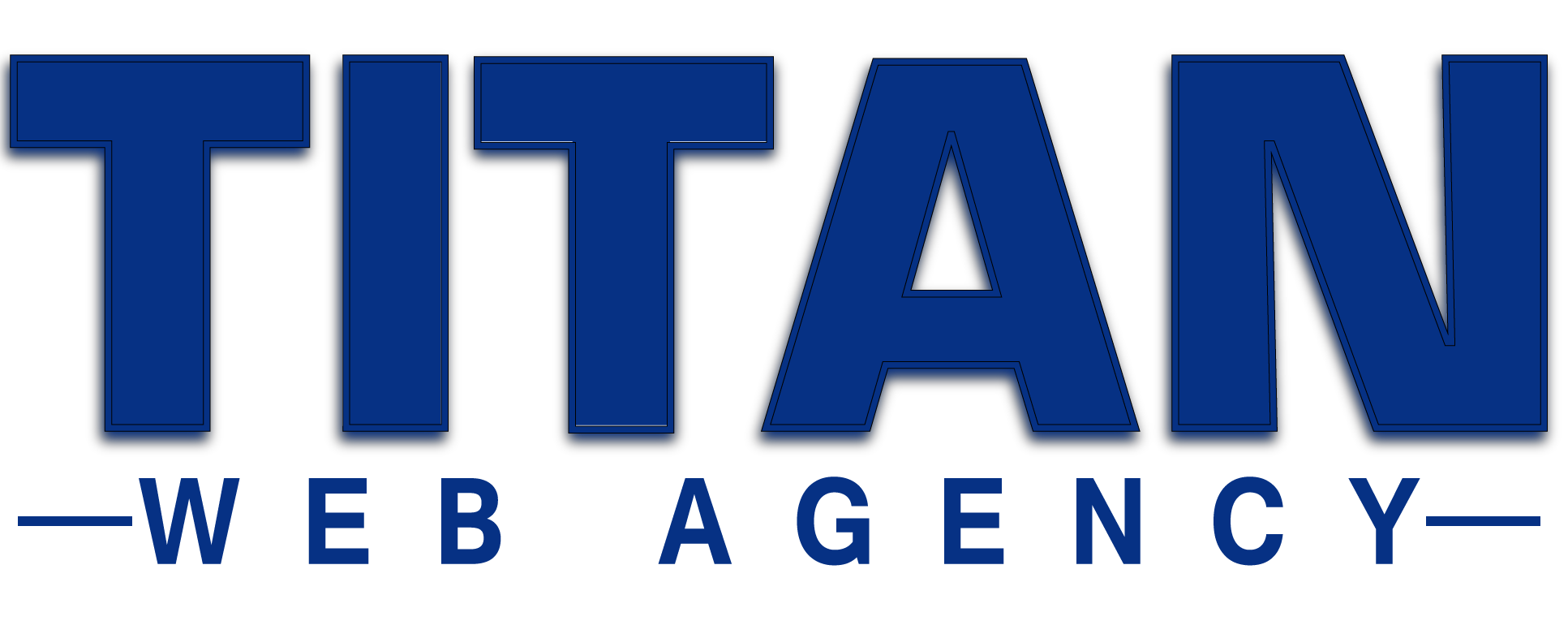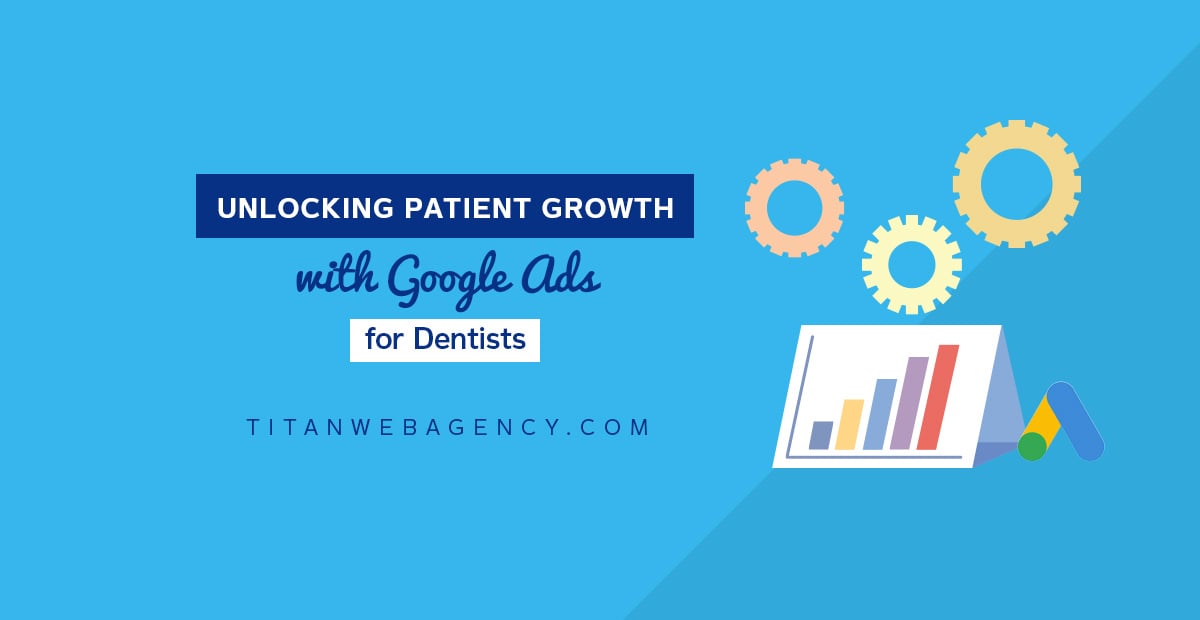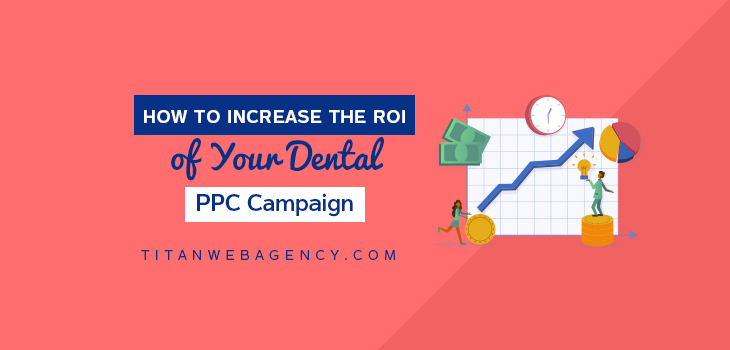Running a dental practice is a lot of work, not only with patient care and staff, but also staying up-to-date about the latest technology and treatments. Did you know that 71% of people go to the Internet when searching for a dentist? 71%!!! It goes without saying that if you don't have a competitive online presence, you are losing your share of that pie.
A well-designed dental marketing strategy can help dental practices attract new patients at the exact moment they’re seeking care. A well-designed marketing strategy isn't single-sided. It has multiple aspects, including AI search optimization, local SEO, review management, and more.
At Titan Web Agency, we understand the unique marketing challenges in the dental field, whether you’re running a single office or overseeing multiple locations. There are limitations to each form of marketing. However, Google Ads provides an efficient, targeted approach that lets you connect with local patients actively seeking dental care. It’s a cost-effective tool that maximizes your visibility and attracts patients who need your expertise.
In this post, we’ll walk you through each essential step of setting up a Google Ads campaign for dental practices. From selecting the right keywords that align with patient needs to crafting compelling ad copy and optimizing your budget, we’ll cover everything you need to attract more patients and help your practice grow.
Listen to this podcast:
What Are Google Ads and How Do They Work?
Google Ads is an online advertising platform that enables businesses to connect with potential customers when they’re searching for relevant services. For dentists, this means your practice can appear at the top of search results when someone types in terms like “dentist near me” or “emergency dentist.” With Google Ads, you can reach people who need your services and want to contact a dentist right now!
There are four main types of Google Ads: Search Ads, Display Ads, Video Ads, and Local Search Ads (LSA's).
Today, we will be talking primarily about search ads because that is where the money is.
-
Search Ads: appear at the top of Google Search results when someone searches for specific terms related to your services. These ads are highly visible and catch potential patients at the exact moment they’re looking for dental help.
-
Display Ads: show up on websites across the internet that partner with Google. These ads can be effective for brand awareness, reaching a broader audience who may not yet know they need dental services but could be interested in learning more. They are cheap but don't convert very well, hence being good for brand awareness.
-
Video Ads: run on platforms like YouTube, providing a dynamic way to introduce your practice and services through engaging video content.
Each ad format serves a different purpose, so your choice will depend on your goals—whether you want to increase brand visibility, focus on a specific patient need, or attract new bookings.
Google Ads allows you to control how much you spend on your ad through a cost-effective pay-per-click (PPC) model. You only pay when someone clicks on your ad. In other words, with this practical tool, you can attract potential patients without spending money on impressions that don’t lead to action. Your best bet is to partner with a digital marketing agency specializing in PPC for dentists.
By targeting specific keywords—such as “teeth whitening” or “dentist for kids”—you can ensure your ads are shown to the right people at the right time, increasing the likelihood of turning searchers into new patients for your practice.
The Benefits of Using Google Ads for Dental Practices
Google Ads is a powerful tool to increase your practice's online visibility and connect with possible new patients at the exact moment they need your services. Unlike organic SEO, which can take months to get results, with Google Ads, your practice will appear at the top of search results right away, which is what anyone looking for urgent care will see first.
This powerful tool is also cost-effective and flexible. You only pay when someone clicks on your ad or completes a desired action (for example, scheduling an appointment). Unlike traditional advertising, with this pay-per-click model, you spend your marketing budget efficiently. Plus, you can always adjust your campaign—whether you're adapting your budget, changing keywords, or modifying your ad copy—which gives you complete control over your marketing strategy.
Real-time performance tracking is a game-changer for any practice. It gives you detailed analytics that show click-through rates, cost per click, and the number of patient inquiries your ads generate. These data will help you make effective decisions and improve your campaigns for maximum impact. Google Ads makes it easier than ever to track your return on investment (ROI) and ensure that your marketing dollars are working for you.
Another key advantage is hyper-targeted advertising. Advanced art targeting features will make your ads reach potential patients who are actively searching for dental services in your area. Such precision makes your practice visible to the right audience, exactly when they need you.
Ultimately, Google Ads helps you stay competitive in the digital age. With its flexibility, real-time insights, and ability to target local patients effectively, it’s a valuable tool that adapts to the needs of any dental practice, big or small.
Why Dentists Should Invest in Google Ads
You may be wondering, okay, maybe Google Ads works for some, but not in my market. Well, let's discuss that.
1. Growing Competition in the Dental Industry
With so many new dental practices, competition is tough. Standing out in this crowded market requires a smart, targeted approach—and that’s where Google Ads comes in. With Google Ads, you can adjust your campaigns to target specific search terms and demographics, making your practice visible to the right people at the right time and giving you a significant edge over competitors who may not be tapping into the full potential of digital advertising.
2. Reaching Local Patients with Precision
For dental practices, local visibility is everything. With Google Ads, geo-targeting your ads will only be shown to people in a specific geographic area, such as those searching for a "dentist near me." This makes your practice more visible to local patients. With features like location extensions, you can also boost your ads by adding your practice's address, phone number, and a direct link to your map. Nearby patients can now easily find you, schedule appointments, and choose your practice over others.
3. Harnessing the Power of Analytics to Drive Success
One of the most powerful aspects of Google Ads is its analytics tool, which lets you monitor and track each campaign's performance in real time, analyzing click-through rates, conversions, and cost per click. Google Analytics will give you valuable insights into what’s driving patient inquiries and appointments. So, you can always improve your campaigns—either adjusting your ad copy, changing your keywords, or reassigning your budget. The key data this tool provides can always help you make well-thought-out decisions that maximize your return on investment (ROI).
How to Create an Effective Dental Google Ads Campaign
1. Keyword Research and Selection
Effective keyword research is key to a successful Google Ads campaign. Focus on high-intent keywords—terms like “emergency dentist near me” or “teeth whitening.” By choosing keywords that people could type in a search engine and match the services your practice offers, your ads will reach those most likely to convert into patients.
Think about your patients’ needs: Are they dealing with an emergency, looking for cosmetic treatments, or seeking routine care? Understanding their motivations helps you identify the right keywords.
Use tools like Google Keyword Planner to refine your list. It shows what local patients are searching for, including search volume, competition levels, and estimated cost-per-click (CPC). By targeting the right keywords, your ads will reach the people who need your services most at the right time.

2. Writing Effective Ad Copy
The first thing potential patients will see is your ad copy. It should be impactful and persuasive.
To create compelling ads, follow these key guidelines:
Be Clear and Concise: Every word counts. Communicate your practice’s key benefits quickly—whether it’s emergency dental services, cosmetic treatments, or family care. Highlight what’s most relevant to your audience’s immediate needs.
Use Strong Calls to Action (CTAs): Encourage potential patients to take the next step with action-oriented phrases. A clear CTA like “Book Your Appointment Today” or “Call Now for Immediate Care” can prompt them to act right away.
Highlight Your Unique Selling Propositions (USPs): To stand out among others and build trust, think about what makes your practice different from others. Do you offer affordable care and state-of-the-art technology, or is your team warm and friendly? Emphasize what makes you unique.
Focus on Patient Benefits: Don't just list your services; explain how they help. For example, “Get Relief Fast with Our Emergency Dental Services” addresses a personal need for quick care and reassures a potential patient that you can help.
Create Urgency: Add a sense of urgency to motivate action. Use phrases like “Call Today to Reserve Your Spot” or “Limited-Time Offer.” This inspires immediate click-throughs and drives conversions.
This isn't an exhaustive list of course, but it touches on a few of the more important things you'll want to touch on.
Following these tips, you can create ad copy that resonates with patients and compels them to click on your ad.

3. Optimizing the Landing Page Experience
Once a potential patient clicks on your ad, the next step is to ensure they have a seamless experience on your landing page.
What is a landing page? A landing page is a page dedicated to a particular service that you are marketing (advertising in this case), with clear calls to action. They'll typically be without clutter, and not be buried in your website. The issue when running Google Ads for dentists is that many will send traffic to a service page- think- the 'Invisalign' page on your website. While that is fine, people will often get distracted by other things on your site, so it's best to create a page dedicated to Invisalign without all the extra menu distractions. See the example below.

Align with the Ad’s Promise: Your landing page should deliver exactly what the ad promised. If someone clicks on an ad for emergency dental services, they should immediately see those services featured prominently on the page.
Mobile-Friendly and Easy to Navigate: Since most patients browse on mobile devices, make sure your landing page is responsive, quick to load, and easy to navigate on any device. The simpler and more intuitive the experience, the more likely they’ll stay and book.
Clear Contact Information: Make it easy to find contact details, such as your phone number. It would be a good idea to add a click-to-call button. Offering multiple ways for patients to reach you (call, form submission, or chat) increases your chances of conversion.
Highlight Services and Reviews: Include what is most relevant to your visitors If they click on an ad for teeth whitening, feature that service upfront, along with any positive reviews from satisfied patients. Trust signals, like testimonials, can play a major role in their decision-making process.
Simple Appointment Scheduling: Make scheduling easy. A clear call-to-action like “Book Your Appointment” or “Get Started Today” should stand out and ensure that the scheduling process is quick and simple.
By aligning your landing page with your ad, ensuring it’s easy to navigate, and offering a smooth path to booking an appointment, you increase the likelihood of converting clicks into actual patients.

4. Budget Planning and Allocation
Google Ads offers flexibility. You can start with a small budget to test your ads, and based on their performance, you can gradually adjust them.
Distribute funds to target keywords that align with your services. Although broad keywords may seem appealing, specific, high-intent terms work better to attract the right patients.
It's also important to balance your Google Ads budget with other marketing strategies, like reputation management (getting more positive reviews) and dental SEO, to expand your reach and connect with possible patients across various channels.
By starting with a small budget and adjusting where you see there is additional opportunity, you can increase your chances of success.
Two Strategies to Maximize Results
After exploring the fundamentals of setting up campaigns, let's look at some advanced strategies to maximize your return on investment and achieve even greater success:
1. Ad Extensions for Enhanced Engagement
Ad extensions add valuable details to your ads, making them more visible and engaging. Call extensions display your practice's phone number directly in the ad, and location extensions show your address and a map marker. These features make it easier for patients to connect with you.
Another extension that can make your ad stand out and gain traction are site link extensions. They can direct patients to key pages like services or booking options. Callout extensions, highlighting unique offers like "Free Consultation" or "Emergency Services Available," can further attract patients’ attention. Leveraging these extensions increases your ad’s visibility and provides additional ways for patients to take action, leading to more conversions.
2. A/B Testing for Continuous Improvement
A/B testing is an incredibly useful tool that can make the most of your Google Ads campaigns and help refine them. You can test various elements like headlines, descriptions, or calls-to-action (CTAs) and check what works and what doesn't.
Regularly conducting A/B tests ensures your ads stay relevant and effective, leading to higher engagement and better conversion rates. Over time, this approach will help you maximize the performance of your campaigns and continuously improve your marketing strategy.
Just be sure you have enough data to come to a conclusion. Many who run tests don’t let the tests run long enough, or they change multiple things at once, making it difficult to know if their test yielded any different results.
How to Get Results for Dentists with Google Ads
Now that we've covered the basics of setting up a converting ad campaign, let’s talk about some more tips that can help you maximize the effectiveness of your campaigns.
1. Focus on Local Patients
To attract more patients, focus on reaching those nearby who are most likely to visit. Google Ads’ local targeting features allow you to display ads specifically to people in your area, maximizing relevance and efficiently using your budget to connect with local patients. Additionally, using location-based keywords like “dentist in [Your City]” enhances visibility for patients actively searching for nearby services. Consider leveraging Local Service Ads for dentists as well, which promote your practice directly to users searching for dental care in your area, helping you stand out and attract high-intent local patients.
Local Service ads (while they are always changing) show up differently than traditional Google Ads, as you can see in the example below.

2. Make Sure Your Landing Page Is Mobile-Responsive
It’s crucial that your landing page is fully optimized for smartphones and tablets since many patients search for dental services on mobile devices. A mobile-responsive design provides a flawless browsing experience, allowing potential patients to easily navigate, complete forms, or call your practice directly from their devices. Integrating dental call tracking software can further enhance this setup by tracking and analyzing calls from mobile users, giving you valuable insights into patient engagement and helping refine your mobile strategy. Making it simple to connect with you on the go can significantly boost engagement and conversion rates.
3. Use Ad Extensions Whenever Possible
As mentioned before, ad extensions are huge! Use them!!!
Ad extensions enhance your ad's visibility and give potential patients quick access to important details about your practice. Adding features such as call buttons, location information, and site links can make your ad more engaging and informative. These extensions encourage direct interaction with your ad, increasing both its visibility in search results and your click-through rate. A mobile-responsive page with an easy user experience can get more patients to connect with your practice.
4. Create Call-Only Campaigns
Call-only campaigns are ideal for dental practices that prioritize direct phone calls over website clicks, simplifying contact for potential patients. These campaigns make it easy for people to call directly from the ad, which is especially useful for urgent services, such as emergency dental care, where patients seek immediate assistance. Call-only campaigns can also help build personal connections and attract patients who prefer speaking directly before booking an appointment.
5. Avoid Overspending
Set a well-defined budget and closely monitor campaign performance to make sure every dollar is working toward measurable results. Begin with a conservative budget, then adjust based on what performs best. Focus on keywords that balance between cost and effectiveness, avoiding high-cost terms that may not yield solid returns. By fine-tuning the money you spend, you can maximize results without stretching your budget too thin.
Frequently Asked Questions
What other PPC options are available for dental practices?
Besides Google Ads, dentists can consider Bing Ads and Facebook Ads. Bing Ads typically face less competition, leading to lower cost-per-click rates, and are useful for targeting an older demographic. On the other hand, Facebook Ads allow precise targeting based on user demographics and interests, making it ideal for reaching potential patients interested in services like cosmetic dentistry.
Bing Ads have a higher intent as people will see your ad when they are actively searching for your services. Ads on social media (Facebook/Instagram) reach viewers who are much more passive, and typically, the leads are lower in quality.
Both platforms can be effective in their own right and can connect you with different patient groups.
How much should dentists spend on PPC ads?
A typical minimum budget is at least $1000 per month (that's an absolute minimum, and I wouldn't recommend it in every case; there are a lot of factors to consider). Determining your budget depends on a few factors:
-
Practice Goals: If you're in growth mode, you may want to invest more to attract new patients. If you're trying to get more cosmetics, implants, etc., just understand that those are more expensive/competitive, and your budget needs to reflect that.
-
Local Competition: In highly competitive areas, a larger budget is often necessary to make any sort of traction.
-
Skill & Strategy: Practices can reduce costs by bidding on the right keywords and optimizing campaigns. In other words, if you hire a company that is experienced in managing dental Google Ads campaigns, you'll likely be able to get better results for a lower cost than if you go with a generalist company or you try to do it yourself.
Your budget should align with your goals and local market conditions. Generally, $2000 per month is the recommended amount in most situations.
How do I differentiate myself & get people to click on my ads?
Now that you’re familiar with Google Ads, you might be asking, “Okay, now what?”
Start by identifying what makes your dental practice stand out. Write down your unique value propositions whether it’s your specialized services, patient care approach, or the technology you use.
Once you’ve identified your key selling points, you can try to come up with some ad copy. Google Ads also has some tools to help you come up with copy, but have this list of your differentiators available when you go to create your ads.
Keep your messaging clear and authentic to build trust and attract new patients.
Let’s Help Grow Your Practice with Dental Google Ads Today!
Google Ads increases online visibility and is a powerful strategy for attracting new patients.
With these outlined strategies, you can optimize your campaigns, track results, and drive more qualified leads to your practice.
Looking to get more out of your Google Ads campaigns?
Schedule a FREE consultation!
Let's help your dental practice attract more patients with less wasted spend — no pressure, just results...
Tyson Downs is the founder of Titan Web Agency, a company specializing in marketing for dental professionals. With an impressive track record of working with over 100 dental practices, Tyson has a deep understanding of the unique marketing needs within the dental industry.












.png)
.png)

.jpg)
